When the Company first started using pine for pulping, they had no plantations of their own. They sourced pine pulpwood from Government plantations in various parts of Victoria and South Australia, and the wood was railed to Maryvale. It must have cost a great deal. I remember pulpwood being cut for Maryvale in the Forests Commission plantations at Stanley, in Victoria’s North East. The pulpwood billets were loaded on to a truck and were delivered to the railway station in Beechworth, where they were hand loaded into open rail wagons. They were then railed via Melbourne to Maryvale.
Pine Harvesting
When their first pine plantations were about 12 years old, the Company started thinning them for pulpwood. Obviously, this led to a marked cost saving, so the plantations were thinned hard. Maryvale Mill’s pine wood line could only take 1.8m billets with a maximum diameter of 30cm. The wood was hand cut, stacked in the plantation row in neat heaps and extracted to the road side. Initially, this was done using old ex-military Blitz 4x4 trucks, which were eventually superseded by Timberjack skidders. The Blitzes were then used to load the billets on to trucks for transport to Maryvale. Methods kept evolving and forwarders gradually replaced skidders and Blitz’s, as they carried out extraction and truck loading more efficiently and safely. While modern harvesting methods have continually changed, forwarders remain a key piece of equipment.
Pine logging contractors met migrant ships as they docked in Melbourne and recruited men as cutters. They transported them to Gippsland, put them up in makeshift camps and started them working. No training seemed to be involved. I remember asking a new cutter once, in about 1968, how his new chainsaw was working. He told me that it had been fine at first, but it wasn’t cutting so well now. I asked him how often he sharpened it. “You have to sharpen them, do you?” he replied. I gave him a brief demonstration of how to sharpen his saw, for which he was very grateful.
The Company decided to build a particle board plant in Rosedale to make a product they called Pyneboard. (This plant commenced in 1962/64 and closed in 1978). This put a deal of stress on the plantations to produce enough wood to supply both Pyneboard and Maryvale. In 1972 to 1974 Australia went through a boom in which full employment was achieved, and the supply of people to work in the physically hard job of pulpwood cutting started drying up.
The Company’s General Manager, Les Schultz, tasked me with the job of mechanizing pine harvesting.
At the time, the CSIRO had a small group researching timber harvesting, headed by Bill Kerruish. Bill spent a year in Sweden investigating the Swedes’ harvesting methods. On return he found an engineering company in Brisbane called RL Windsor whose principal, Rob Windsor, was willing to co-design a prototype tree harvester with Kerruish. Windsors did a lot of engineering work for APM at the time, so it was a logical choice to develop a tree harvester.
So the Windsor harvester came into being. It was built on a Timberjack chassis and looked a bit like a Yabby. It was designed to shear off a tree, lift it up to a delimbing carriage mounted on its back and delimb the stem. It missed the branches on the bottom 1.5 metres of the stem and could only delimb each stem for a length of about 9 metres. The rest of the stem was wasted. The partially delimbed stem was then dropped into a bin on the side of the machine. When the bin was full, the heap of partially delimbed stems was tipped on to the ground. The wood had then to be cut to the required 1.8 metre lengths and the remaining branches had to be removed.
The Company was willing to try it. No other tree harvester was available in Australia, so the Windsor came down to Gippsland for trials in 1972.
No one had ever worked the machine, so there were no manuals or instructions to go by. I had a small three man crew to carry out harvesting research, and we tentatively started working this new machine.
It soon became obvious that a young man, John Killeen, was the outstanding operator. However, even he had trouble keeping the machine going. Its utilization averaged about 45%. The rest of the time it was broken down and being repaired. As well, it produced wood in a form unacceptable to Maryvale’s wood line, so the wood had to be further processed by hand to make it acceptable to the mill.
However, in 1974 it looked as though Maryvale would run out of pine pulpwood, as our contractors could not find enough cutters to manually produce the volume of pulpwood required. So Les Schultz ordered two more Windsor Harvesters, and I had to persuade a contractor or two to take them on. The prototype machine was returned to Kerruish’s CSIRO group. Jack Irish and Gary Leeson of LJ Crawford agreed to take on a Windsor each. They were responsible for the running and maintenance costs, and had to produce the wood as 1.8 m long billets without limbs. This required manual work after the Windsor had finished with the stems, and the cost was greater than doing the whole job by hand.
Keeping these machines going was no mean feat. The most successful contractor was Jack Irish, and the only way he could keep his machine going was to have a supply of spare hydraulic cylinders to replace the ones on the machine when they failed. He would replace the failed cylinder with a good one and have the unserviceable cylinder repaired ready for the next failure. The transmission on the Timberjack carrier also failed, so Jack had a spare reconditioned transmission as well.
It was obvious that the Windsor was not the answer to mechanically harvesting Pinus radiata.
I had been keeping a sharp eye on overseas developments through the excellent head office library, which was able to supply me with all the harvesting magazines from the two countries that seemed to be in the front of mechanical tree harvesting - Canada and Sweden. P.radiata had a few characteristics that made it particularly hard to harvest mechanically.
- It was not self pruning
- The branches would not snap off – they had to be cut
- Often the branches inclined upwards, which allowed delimbing knives to slide over them rather than cutting them off, if coming from the butt of the tree
- In the then current plantations, about 20% of the trees had multiple leaders and had very deformed stems
- Green radiata weighs approximately one tonne per cubic metre. In the northern hemisphere, softwoods weigh about 600 kg/m3 .
So I searched the literature for a machine that appeared to be able to handle all these characteristics.
The only one that appealed to me was the Swedish Logma. It was a single purpose machine, designed to pick up felled trees, delimb them and leave them in a heap on the ground. It was the only machine that seemed able to handle limbs such as those on radiata. The fact that it did not do any of the other actions we would have liked was secondary. At least, it seemed to be able to delimb our problem radiata.
I said as much to Les Schultz, and his response was typically immediate. “Go and look at it” he said.
So in 1976 I went to Sweden on a trip organized by Noel Burrows of Kockums, the Swedish company who manufactured the Logma. Noel had a good idea of what was required, and had capably understood what myself and the other experienced member of our group, West Australian logging contractor Mayne Coverley, were looking for. The weakness of the Logma was not its delimbing capability, but its inability to buck the delimbed stems into the required lengths. Luckily, one of the Swedish Kockums representatives knew of a contractor in the south of Sweden who had fitted his Logma with a hydraulically powered bucking saw alongside the operator’s cab, under the delimbing boom. This made the machine acceptable, as both Mayne and I immediately recognized.
Kockums agreed to bring a Logma fitted with a bucking saw to Australia for a 3 month trial in APM Forests (APMF) plantations. They would pay for the transport of the machine to us, and we agreed to pay for its return to Sweden if the trial was a failure. If the machine was considered a success, APMF would buy it for an agreed cost.
The weakness in the arrangement was that there was no one in Australia who could operate a Logma. So I suggested to Les Schultz that I would draft a letter to APPM, ANM and Bowaters, the other three companies who had a high interest in the upcoming trial, offering them the results of the trials, and the invitation to inspect the trials at their convenience, in return for them paying for a skilled Swedish operator to come to Australia for the three month trial. They immediately agreed to this arrangement, and Kockums arranged an excellent operator for the machine.
We selected an area in our Silver Creek Tree Farm for the trial, which was to be in a thinning operation. Silver Creek was chosen for two main reasons:
- It had a high growth rate due to its good soils and high rainfall, and as a result the tree form was poor.
- It was hilly, so the terrain would be more challenging than most of the company’s Tree Farms.
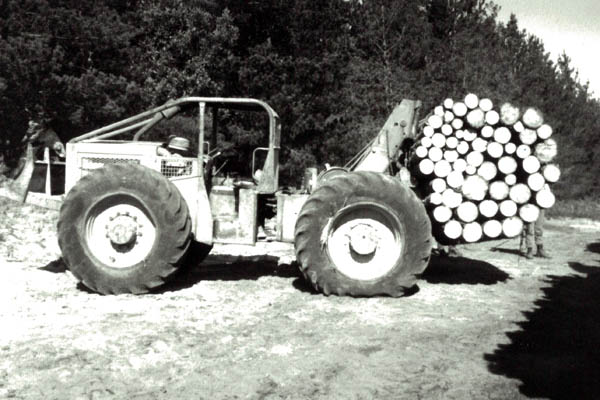
Fig. 1 Timberjack skidder with 6 foot (1.8m) pine billets.
About 1967
Source: O Raymond
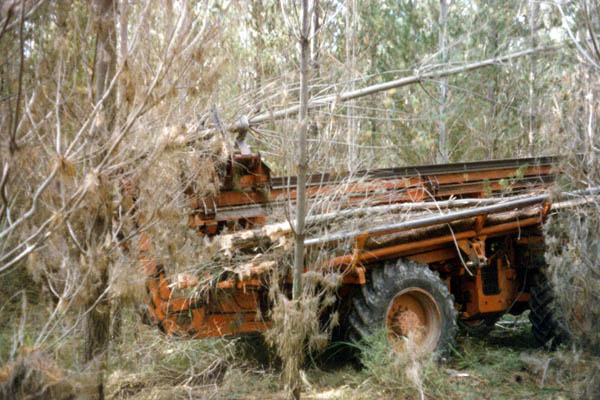
Fig. 2 Windsor Tree Harvester conducting first thinning in Pinus radiata.
About 1973
Photo: O Raymond
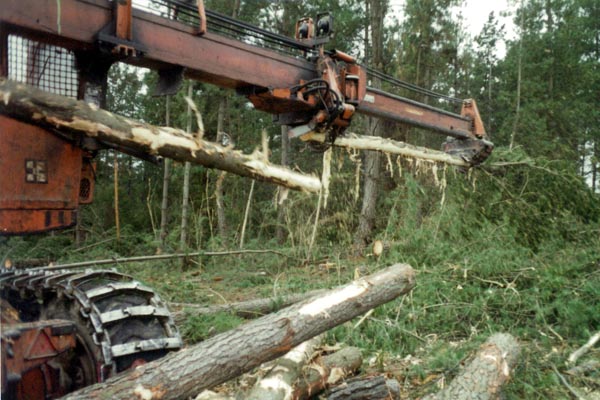
Fig. 3 Logma T310 Processor
About 1980
Photo: O Raymond
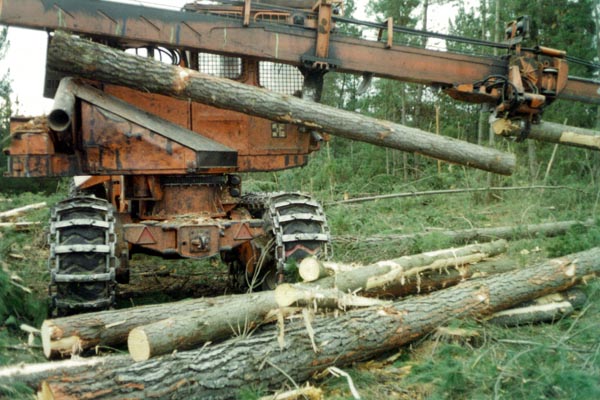
Fig. 4 Logma T310 Processor
About 1980
Photo: O Raymond
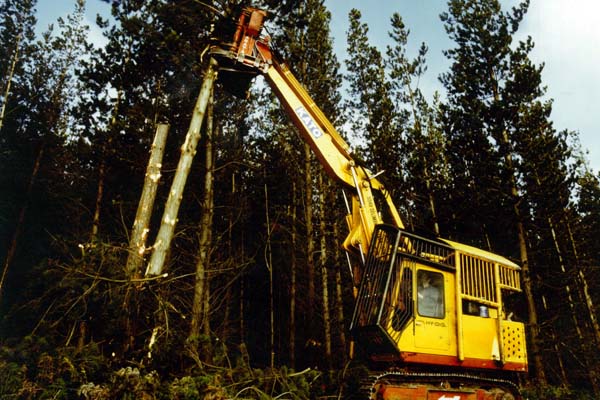
Fig. 5 Kato excavator with Waratah Head working in Pinus radiata.
About 1981
Photo: O Raymond
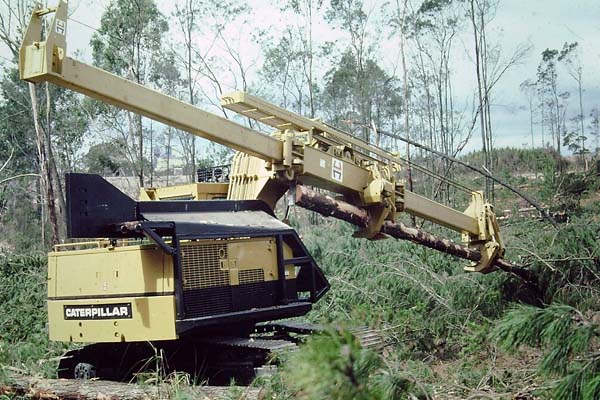
Fig. 6 Caterpillar harvester delimbing trial near Loy Yang, Gippsland
15 March 1983
Photo: O Raymond
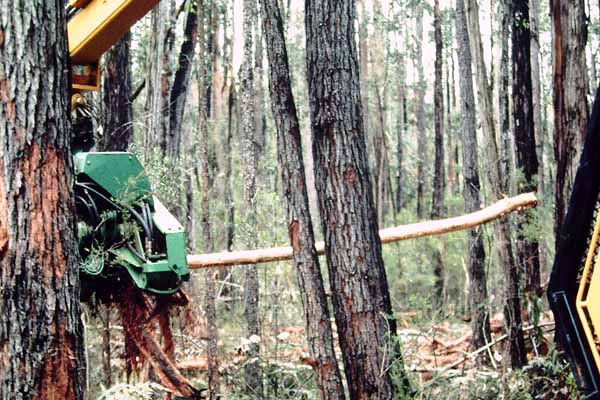
Fig. 7 Lako Harvester head removing bark from pulpwood, Silver Creek Tree Farm.
November 1985
Photo: O Raymond
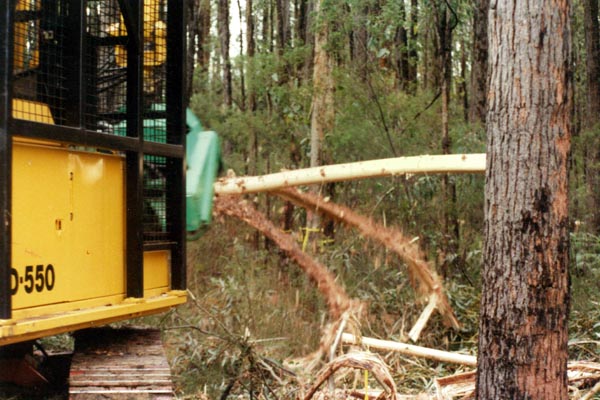
Fig. 8 Lako Harvester head removing bark from pulpwood, Silver Creek Tree Farm.
November 1985
Source: O Raymond
We borrowed a shear felling head from Bill Kerruish’s organisation in the CSIRO, and rigged it on a tracked front-end loader to cut and bunch the stems for the Logma. This was fine in pulpwood operations, but when we later moved into sawlog production the shattering of the stems for about 45cm up from the butt caused by the hydraulic pressure of the shear made it unsuitable. However, Kockums had a feller buncher with a specially designed hydraulic chainsaw felling head that overcame this problem, so we bought one of them to complement the Logma processor.
After a month, it was obvious that the Logma was an outstanding success, so the other two months of the trial were spent in training my three man crew in its operation. Once more, the outstanding operator was John Killeen. At the end of the three months, the Swede said that John was as productive on the machine as he was himself.
Ironically, the Logma was never used by us in a thinning operation. The sawmilling subsidiary of APM, Brown and Dureau, had built a sawmill outside Morwell, and the Logma spent the rest of its life in clear falling operations producing sawlogs for this mill as well as pulpwood for Maryvale and Pyneboard.
The advent of the sawmill meant the required cut from the company’s plantations had increased considerably, so it was decided to buy another Logma and have two contractors operate them.
Gary Leeson and Robert Crawford tendered for the jobs, on the basis that they would cover the operating and maintenance costs, and would deliver wood for an agreed price per cubic metre. John Killeen trained the contractors’ operators and the operation was a great success. As a result of the meticulous tree measurement and work study carried out by Don Hay during the trials, we had a good grasp of the machine’s productivity which varied with tree size, so we set the contractor's quotas to maximise their output and so minimize their costs, and so the cost to us of the wood.
Within 12 months we had to increase these quotas by about 20% as the operations became more efficient. Subsequently, ANM bought 10 Kockums systems comprising Logmas, feller bunchers and forwarders for their contractors to supply pulpwood to their Albury Mill. Noel Burrows asked me if he could “borrow” John Killeen as a trainer and with John’s consent I agreed. John was taken to Sweden and thoroughly trained as an instructor on these machines, not only in operating them but also in their routine maintenance. He was then used by Kockums as the instructor for ANM’s logging contractors.
However, this didn’t solve the problem of mechanizing harvesting in APMF’s thinnings. The output of any machine processing one stem at a time is very dependent on the size of those stems, so we looked for a cheaper solution than the Logma.
At this time a New Zealand equipment manufacturer by the name of Waratah had made what amounted to a feller buncher mounted on an excavator chassis with sharpened grasping knives. The machine grasped the tree, lifted its head up, taking the branches off as it went, and sheared off the top of the tree when it reached the end of its stroke. This machine was promising, but it had two disadvantages.
- It was limited in the length of the stem it could delimb, and
- It could not accurately measure the lengths of the billets it sheared off, as it had no measuring device
Eucalypt Harvesting
One day I was watching John Killeen operating the machine, and he did something I had never seen before. He had become frustrated that he was often throwing away the merchantable tops of the trees because he could only reach to a certain height. So what he did was he grasped the tree, sheared it off, lifted it up and opened the shear blades. The stem then dropped through the delimbing knives which took the branches off on the way down. John then cut the stem with the shear into approximately 1.8m lengths which he judged by eye.
I was amazed at this and asked John to repeat the operation, which he did several times.
The drawback was that John had to do some slow operating due to the machine’s hydraulic sequence being unsuited to his new found method.
I immediately got in touch with the manufacturer in NZ and asked him to come over urgently to see this new technique and see if he could rearrange the hydraulics to speed up the process.
He was equally amazed at what John had figured out and in a very short time he had changed the hydraulics so that John’s new technique could be carried out smoothly. However, Waratah could not work out a satisfactory length measuring system, and despite my searching for a solution to this problem we never came up with a satisfactory answer.
This was a great disappointment as the machine had eliminated one mechanical operation, which increased it mechanical reliability. It used gravity and not a mechanical method to pull the stems through its delimbing head. So a great machine came to an end, as all our pulpwood operations had to be able to produce fence post lengths for preserving, and these had to be cut to a precise length.
Waratah produced a few of their original harvesters which they sold to a Tri Board mill in Kaitia in NZ, but they were never a success.
However, Waratah then produced a head that had a chainsaw in place of the original shear and feed rolls to pull the stem through the delimbing knives. It also incorporated a measuring wheel that allowed the machine to measure lengths precisely. This was a success, and later and larger machines are currently widely used today. They were only possible as a result of the magnificent tree breeding work by many people and organisations that had produced a radiata that resembled the Spruce and Pine of the northern hemisphere, straight trees with no forks and branches that came out at right angles to the stem. This type of machine made mechanical pine thinning operations economically possible.
After a while, the Swedes increased the price of their equipment to such an extent that we needed to find alternatives. By asking around, I was given the name of James Nagorka from Hamilton in the Western District, who had started manufacturing very large agricultural tractors similar to those produced mainly in America, but for a lesser price. I asked him to come to Gippsland to have a look at a Swedish forwarder and see if he could make similar machines in his workshop. His comments were encouraging. He named components that could be bought off the shelf, ranging from engines to transmissions, axles and differentials, and said he would have no difficulty building such machines. I gave him the name of a suitable hydraulic crane and he went home and designed a forwarder. When he was ready, I arranged to fly our pine contractors to Hamilton to have a conference with James, and the result was that Gary Leeson agreed to buy a forwarder from James. This was successful and worked for many years in our harvesting operations. It only had one drawback. The Swedes had access to very high tensile lightweight steel, that James could not get in Australia, so his machine was heavier than the Swedish machines – a drawback in wet boggy conditions.
We then had to find a substitute for the Logma. By now, the Canadians had seen how successful Logmas were, and had developed two similar machines mounted on excavator chassis. I went to Canada to inspect them and arranged a trip with Gary Leeson and Robert Crawford to inspect the machines available. Gary was impressed by a Koehring processor and ordered one for his operation. Robert later built his own processor mounted on a Caterpillar excavator, using slack periods in his own workshop to do the construction.
Initially eucalypt pulpwood was produced by hand cutters. The process involved falling the tree, delimbing it, cutting it in to 1.8m lengths as required by Maryvale Mill, debark it and splitting it into no larger than30cm diameter billets. Splitting was often carried out using splitting guns, which resembled a cannon with a sharpened muzzle. Black powder was poured into the mouth of the gun followed by a tamping paper. The gun was then hammered into the end of the 1.8m length to be split. A 15cm length of safety fuse was then placed into the touch hole. A crow bar was placed behind the gun, firmly dug into the ground and the fuse was then lit. The resulting explosion blew the wood into smaller diameter billets. The billets were then hand stacked into metal pallets which were winched on to trucks for transport to the mill. Later, the splitting operation was carried out by hydraulic splitters mounted on old truck chassis, and usually the billets were ejected into metal pallets already on a truck. All this was dictated by the wood chipping line at Maryvale, which could only accept billets up to 30cm diameter and 1.8m long.
Eventually APM decided to build two new wood lines for their Maryvale mill, one for pine and one for eucalypt. I was nominated as a member of the design team for these lines, which as far as I could ascertain was a first for wood lines. Previously they had been built by engineers with no input from the foresters who grew the trees they would be processing. The results were economically bad, as they invariably seemed to increase the cost of the wood delivered to the plant. Engineers seemed to consider that all trees grew straight and neat, and so they built wood lines that would have been great to process large pencils, but which struggled with real life tree stems. As an example, I was able to persuade the design team to increase the acceptable diameter of eucalypt pulpwood resulting in major cost savings and productivity in the forest. I also spent a day taking the Canadian design engineer from the construction firm involved, HA Simons, around our pine plantations and logging operations, pointing out to him why we were unable to change the shape of our trees and so he would need to build a line capable of handling some pretty rough stems. To his absolute credit, he did exactly that, once more saving the Company money in their wood costs. Pine was accepted in random lengths between 3 and 6 metres, and eucalypt in 3 metres to truck lengths.
Some time later I showed the pine wood line to the chief forester from New Zealand Forest Products (NZFP) and he was amazed at what the line could handle. He asked me who had designed it, and when I told him it was Simons he said that they had just designed a pine wood line for the NZFP mill in NZ and they were having many problems supplying pulpwood prepared to a standard capable of being handled by the new wood line.
The major problem with harvesting eucalypt species in Victoria is debarking. Nearly all the species used at Maryvale Mill had fibrous bark, which weighed roughly 10% of the combined weight of the stem with the bark on. Further, if the bark came in to the mill, apart from the increased cartage cost for something that had no economic market, the fibrous nature of the bark resulted in the conveyor belts grinding to a halt as they became entangled in bark.
I had long been annoyed, as a forester, in our inability to economically thin the native forests that had prolifically regenerated after being clear felled for sawlogs and pulpwood. There was a large resource available that was being wasted while we waited for nature to kill the suppressed stems in these stands as they grew to maturity. If we could economically thin them, we would not only capture a resource that was wasted before, but we would shorten the time it took for the stands to grow to sawlog size. Bill Kerruish’s CSIRO team was also working on this problem but had not come up with an answer.
At the time, a salesman called Bob Smith was trying to persuade me to buy a Finnish Lako harvesting head, which was mounted on an excavator and used feed rolls to pull the stem through the delimbing knives. The machine was meant for pine harvesting, but I decided to run a small trial with it in eucalypt thinning. One day, the hydraulics to the delimbing knives failed, and we were considering stopping the trial. However, I asked the operator to try processing a few stems without the delimbing knives. To everyone’s amazement, the bark peeled off the stems as they were drawn through the feed rolls.
Kerruish’s team had established that it required much less effort to strip eucalypt bark from a stem if it was twisted off compared to trying to strip it off. We had already trialled the Logma in eucalypt thinning expecting it to be able to strip the bark from the stems, but it had been a failure. So I persuaded Bob Smith to get the bars on the feed rolls of his machine to be modified to an angle, so that they were trying to turn the stem as it was pulled through the feed rolls. As the stem still had its canopy on, it resisted this turning, so a strong twisting moment was applied to the bark. This was effective, and the technique has been used in eucalypt harvesting ever since. It had long been recognized that it was much easier to debark eucalypts if it was done immediately after falling the tree, and here was a machine that debarked each stem as soon as it was felled. Further, it left the bark widely distributed through the stand where its nutrient value would be maximised as it rotted away.
The larger stems at the time were debarked using an excavator fitted with a “Crab Grab” head. This machine was also capable of loading the wood on to the log trucks, so it became widely used in logging operations. However, nowadays some massive tree harvesters using a scaled up version of Bob Smith’s Finnish Lako harvesting head and, manufactured by Waratah, are widely used in eucalypt harvesting operations.
